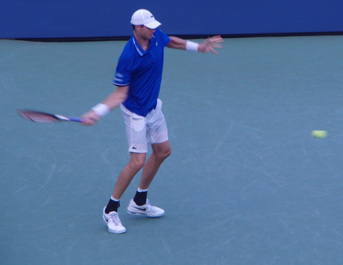Synchronized coordination is what you think of when you are watching an old school tennis match. The player’s strokes seem very rigid and structured. They have stiff arms and their whole body follows one motion. Sequential coordination has many movements and actions taking place. The first actions are in the legs and the force they generate from the ground. This energy moves up the body and is transferred to the shoulder by rotation of the hips and trunk. From the shoulder, the energy moves to the elbow, the wrist, and then the racquet head. This generates greater racquet head speed. Having good sound technical knowledge about tennis strokes is very important for both the tennis coach as well any individual who works with tennis athletes from a physical perspective.
Here are some exercises to increase strength in tennis specific techniques for groundstrokes.
1. Medicine Ball Deep Groundstroke - To create greater force off the ground and to lean into deep shots behind the baseline this drill is perfect. To simulate a deep defensive forehand, have the player start on the service mark. The trainer should toss a medicine ball to the right of the player 3-5 feet behind him/her. The player should retreat back to catch the ball in the same motion as the stroke. After catching the ball, players forcefully throws the ball back mimicking the stroke of a deep forehand or backhand.
2. Medicine Ball Short Groundstroke - To practice moving to and hitting short mid-court balls. Have the player start on the center service mark. The trainer should toss a medicine ball to the right or left of the player 3-5 feet in front him/her. The player should advance forward to catch the ball in the same motion as a stroke. After catching the ball, players forcefully throws the ball back mimicking the stroke of a short aggressive forehand or backhand.
3. Medicine Ball Wide - To help create greater power from an open stance groundstroke. Have the player start on the center service mark. The trainer should toss a medicine ball to the right or left of the player about 5 feet from him/her. The player should shuffle sideways to catch the ball in the same motion as a stroke. After catching the ball, players forcefully throws the ball back mimicking the stroke of an open stance forehand or backhand.
4. Medicine Ball Wall Open Stance - The athlete starts 5-8 feet from a solid wall. Focus on loading the hips and stretching the obliques in an open stance. Rotate the hips as the medicine ball is released as hard as possible at the wall.
5. Wrist Roller - This is important to increase forearm strength, flexion, and extension. Using a wrist roller device, have the athlete grab the device and extend his/her arms out at shoulder height. Slowly lower the weight by flexing and extending the wrist. Once it has reached the ground reverse the process till the weight is at the starting position.
For more details about tennis-specific education check out the Tennis Performance Trainer (TPT) certification program which is aimed toward the tennis coach to better understand aspects of physical training for tennis focused on improving performance and reducing injuries www.itpa-tennis.org/tpt.html
Fitness professionals, strength and conditioning coaches, athletic trainers, physical therapists, chiropractors, medical doctors and other healthcare providers that train and/or treat tennis athletes should look to become a Certified Tennis Performance Specialist (CTPS) which is specifically designed to help individuals that understand sport science/anatomy/physiology and biomechanics, but are looking for tennis-specific information to help apply your knowledge in a more tennis-specific nature. www.itpa-tennis.org/ctps.html
*iTPA Members: More in-depth article posted on the iTPA Inner Circle Member Only Website.





 RSS Feed
RSS Feed
